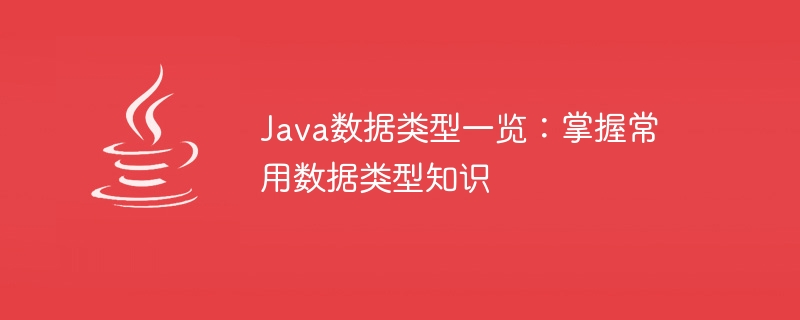Understand common Java data types: Master data type concepts

Java is an object-oriented programming language with rich data types. Today we will introduce these commonly used data types one by one and use specific code examples to help you learn more. Well understood and mastered.
- Basic data types:
The basic data types of Java include integer, floating point, character and Boolean. The following is their detailed introduction:
- Integer type (byte, short, int, long): used to store integer values, representing integers in different ranges. For example, the byte type can store integers between -128 and 127.
byte myByte = 10; short myShort = 100; int myInt = 1000; long myLong = 10000L;
- Floating point type (float, double): used to store values with decimals. The float type represents a single-precision floating point number, and the double type represents a double-precision floating point number.
float myFloat = 3.14f; double myDouble = 3.14159;
- Character type (char): used to store a single character. Characters must be enclosed in single quotes.
char myChar = 'A';
- Boolean: used to represent true or false values. The Boolean type has only two values: true and false.
boolean myBoolean = true;
- Reference data types:
In addition to basic data types, Java also provides reference data types. Reference data types include strings, arrays, classes, etc.
- String: used to store a set of characters. Strings are treated as reference data types in Java, not as primitive data types.
String myString = "Hello World";
- Array: used to store a fixed-length collection of similar elements. An array can be an array of primitive data types or an array of reference data types.
int[] myIntArray = {1, 2, 3, 4, 5};
String[] myStringArray = {"apple", "banana", "orange"};- Class: Class is the core concept of object-oriented programming and is used to create objects. Classes are composed of data members and method members. We can use predefined classes or define new classes ourselves.
public class Person {
String name;
public void sayHello() {
System.out.println("Hello, my name is " + name);
}
}
Person person1 = new Person();
person1.name = "John";
person1.sayHello();In Java, there are other commonly used data types, such as enumeration (enum), BigDecimal, BigInteger, etc. These data types can be used according to actual needs.
It is very important for programmers to master Java's data types. Only by deeply understanding their characteristics and usage can we better write efficient and reliable programs.
To summarize, this article introduces the common data types in Java in detail, including basic data types and reference data types, and illustrates their usage through specific code examples. I hope this article can help everyone better understand and master Java's data type knowledge.
The above is the detailed content of Understand common Java data types: Master data type concepts. For more information, please follow other related articles on the PHP Chinese website!

Hot AI Tools

Undresser.AI Undress
AI-powered app for creating realistic nude photos

AI Clothes Remover
Online AI tool for removing clothes from photos.

Undress AI Tool
Undress images for free

Clothoff.io
AI clothes remover

AI Hentai Generator
Generate AI Hentai for free.

Hot Article

Hot Tools

Notepad++7.3.1
Easy-to-use and free code editor

SublimeText3 Chinese version
Chinese version, very easy to use

Zend Studio 13.0.1
Powerful PHP integrated development environment

Dreamweaver CS6
Visual web development tools

SublimeText3 Mac version
God-level code editing software (SublimeText3)

Hot Topics
 1378
1378
 52
52
 How does Java's classloading mechanism work, including different classloaders and their delegation models?
Mar 17, 2025 pm 05:35 PM
How does Java's classloading mechanism work, including different classloaders and their delegation models?
Mar 17, 2025 pm 05:35 PM
Java's classloading involves loading, linking, and initializing classes using a hierarchical system with Bootstrap, Extension, and Application classloaders. The parent delegation model ensures core classes are loaded first, affecting custom class loa
 How do I implement multi-level caching in Java applications using libraries like Caffeine or Guava Cache?
Mar 17, 2025 pm 05:44 PM
How do I implement multi-level caching in Java applications using libraries like Caffeine or Guava Cache?
Mar 17, 2025 pm 05:44 PM
The article discusses implementing multi-level caching in Java using Caffeine and Guava Cache to enhance application performance. It covers setup, integration, and performance benefits, along with configuration and eviction policy management best pra
 How can I use JPA (Java Persistence API) for object-relational mapping with advanced features like caching and lazy loading?
Mar 17, 2025 pm 05:43 PM
How can I use JPA (Java Persistence API) for object-relational mapping with advanced features like caching and lazy loading?
Mar 17, 2025 pm 05:43 PM
The article discusses using JPA for object-relational mapping with advanced features like caching and lazy loading. It covers setup, entity mapping, and best practices for optimizing performance while highlighting potential pitfalls.[159 characters]
 How do I use Maven or Gradle for advanced Java project management, build automation, and dependency resolution?
Mar 17, 2025 pm 05:46 PM
How do I use Maven or Gradle for advanced Java project management, build automation, and dependency resolution?
Mar 17, 2025 pm 05:46 PM
The article discusses using Maven and Gradle for Java project management, build automation, and dependency resolution, comparing their approaches and optimization strategies.
 How do I create and use custom Java libraries (JAR files) with proper versioning and dependency management?
Mar 17, 2025 pm 05:45 PM
How do I create and use custom Java libraries (JAR files) with proper versioning and dependency management?
Mar 17, 2025 pm 05:45 PM
The article discusses creating and using custom Java libraries (JAR files) with proper versioning and dependency management, using tools like Maven and Gradle.




